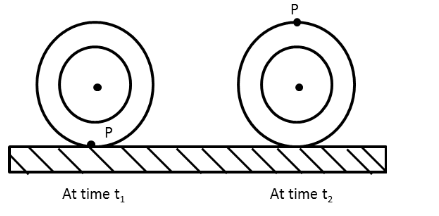
A wheel with radius \[45\,{\text{cm}}\] rolls without slipping along a horizontal floor as shown in figure. P is a dot pointed on the rim of the wheel. At time \[{t_1}\], P is at the point of contact between the wheel and the floor. At a later time \[{t_2}\], the wheel has rolled, through one-half of a revolution. What is the displacement of P during this interval?

A. \[90\,{\text{cm}}\]
B. \[168\,{\text{cm}}\]
C. \[40\,{\text{cm}}\]
D. Data insufficient

Answer
570.3k+ views
Hint: Calculate the horizontal and vertical displacements of point P. Then calculate the resultant displacement of the point P.
Formulae used:
The circumference \[C\] of the circle is given by
\[ \Rightarrow C = 2\pi r\] …… (1)
Here, \[r\] is the radius of the circle.
The resultant displacement \[s\] is given by
\[ \Rightarrow s = \sqrt {s_x^2 + s_y^2} \] …… (2)
Here, \[{s_x}\] is the horizontal component of displacement and \[{s_y}\] is the vertical component of displacement.
Complete step by step answer:
Calculate the horizontal displacement of the point P between the times \[{t_1}\] to \[{t_2}\].
The horizontal displacement \[{s_x}\] of the point P is equal to half of the circumference \[C\] of the wheel.
\[ \Rightarrow {s_x} = \dfrac{C}{2}\]
Substitute \[2\pi r\] for \[C\] in the above equation.
\[ \Rightarrow {s_x} = \dfrac{{2\pi r}}{2}\]
Substitute \[3.14\] for \[\pi \] and \[45\,{\text{cm}}\] for \[r\] in the above equation.
\[{s_x} = \dfrac{{2\left( {3.14} \right)\left( {45\,{\text{cm}}} \right)}}{2}\]
\[ \Rightarrow {s_x} = 141.3\,{\text{cm}}\]
Hence, the horizontal displacement of the point P is \[141.3\,{\text{cm}}\].
Calculate the vertical displacement of the point P between the times \[{t_1}\] to \[{t_2}\].
The vertical displacement \[{s_y}\] of the point P is equal to the diameter of the wheel which is twice the radius \[r\] of the wheel.
\[ \Rightarrow {s_y} = 2r\]
Substitute \[45\,{\text{cm}}\] for \[r\] in the above equation.
\[ \Rightarrow {s_y} = 2\left( {45\,{\text{cm}}} \right)\]
\[ \Rightarrow {s_y} = 90\,{\text{cm}}\]
Hence, the vertical displacement of the point P is \[90\,{\text{cm}}\].
Now calculate the resultant displacement \[s\] of the point P.
Substitute \[141.3\,{\text{cm}}\] for \[{s_x}\] and \[90\,{\text{cm}}\] for \[{s_y}\] in equation (2).
\[ \Rightarrow s = \sqrt {{{\left( {141.3\,{\text{cm}}} \right)}^2} + {{\left( {90\,{\text{cm}}} \right)}^2}} \]
\[ \Rightarrow s = 167.5\,{\text{cm}}\]
\[ \Rightarrow s = 168\,{\text{cm}}\]
Therefore, the displacement of the point P is \[168\,{\text{cm}}\].
Hence, the correct option is B.
Note:One may directly determine the diameter of the wheel to calculate the displacement of point P. But it is the vertical displacement and not the resultant displacement.
Formulae used:
The circumference \[C\] of the circle is given by
\[ \Rightarrow C = 2\pi r\] …… (1)
Here, \[r\] is the radius of the circle.
The resultant displacement \[s\] is given by
\[ \Rightarrow s = \sqrt {s_x^2 + s_y^2} \] …… (2)
Here, \[{s_x}\] is the horizontal component of displacement and \[{s_y}\] is the vertical component of displacement.
Complete step by step answer:
Calculate the horizontal displacement of the point P between the times \[{t_1}\] to \[{t_2}\].
The horizontal displacement \[{s_x}\] of the point P is equal to half of the circumference \[C\] of the wheel.
\[ \Rightarrow {s_x} = \dfrac{C}{2}\]
Substitute \[2\pi r\] for \[C\] in the above equation.
\[ \Rightarrow {s_x} = \dfrac{{2\pi r}}{2}\]
Substitute \[3.14\] for \[\pi \] and \[45\,{\text{cm}}\] for \[r\] in the above equation.
\[{s_x} = \dfrac{{2\left( {3.14} \right)\left( {45\,{\text{cm}}} \right)}}{2}\]
\[ \Rightarrow {s_x} = 141.3\,{\text{cm}}\]
Hence, the horizontal displacement of the point P is \[141.3\,{\text{cm}}\].
Calculate the vertical displacement of the point P between the times \[{t_1}\] to \[{t_2}\].
The vertical displacement \[{s_y}\] of the point P is equal to the diameter of the wheel which is twice the radius \[r\] of the wheel.
\[ \Rightarrow {s_y} = 2r\]
Substitute \[45\,{\text{cm}}\] for \[r\] in the above equation.
\[ \Rightarrow {s_y} = 2\left( {45\,{\text{cm}}} \right)\]
\[ \Rightarrow {s_y} = 90\,{\text{cm}}\]
Hence, the vertical displacement of the point P is \[90\,{\text{cm}}\].
Now calculate the resultant displacement \[s\] of the point P.
Substitute \[141.3\,{\text{cm}}\] for \[{s_x}\] and \[90\,{\text{cm}}\] for \[{s_y}\] in equation (2).
\[ \Rightarrow s = \sqrt {{{\left( {141.3\,{\text{cm}}} \right)}^2} + {{\left( {90\,{\text{cm}}} \right)}^2}} \]
\[ \Rightarrow s = 167.5\,{\text{cm}}\]
\[ \Rightarrow s = 168\,{\text{cm}}\]
Therefore, the displacement of the point P is \[168\,{\text{cm}}\].
Hence, the correct option is B.
Note:One may directly determine the diameter of the wheel to calculate the displacement of point P. But it is the vertical displacement and not the resultant displacement.
Recently Updated Pages
Master Class 11 Economics: Engaging Questions & Answers for Success

Master Class 11 English: Engaging Questions & Answers for Success

Master Class 11 Social Science: Engaging Questions & Answers for Success

Master Class 11 Biology: Engaging Questions & Answers for Success

Class 11 Question and Answer - Your Ultimate Solutions Guide

Master Class 11 Business Studies: Engaging Questions & Answers for Success

Trending doubts
10 examples of friction in our daily life

One Metric ton is equal to kg A 10000 B 1000 C 100 class 11 physics CBSE

Difference Between Prokaryotic Cells and Eukaryotic Cells

1 Quintal is equal to a 110 kg b 10 kg c 100kg d 1000 class 11 physics CBSE

Explain zero factorial class 11 maths CBSE

What is a periderm How does periderm formation take class 11 biology CBSE




